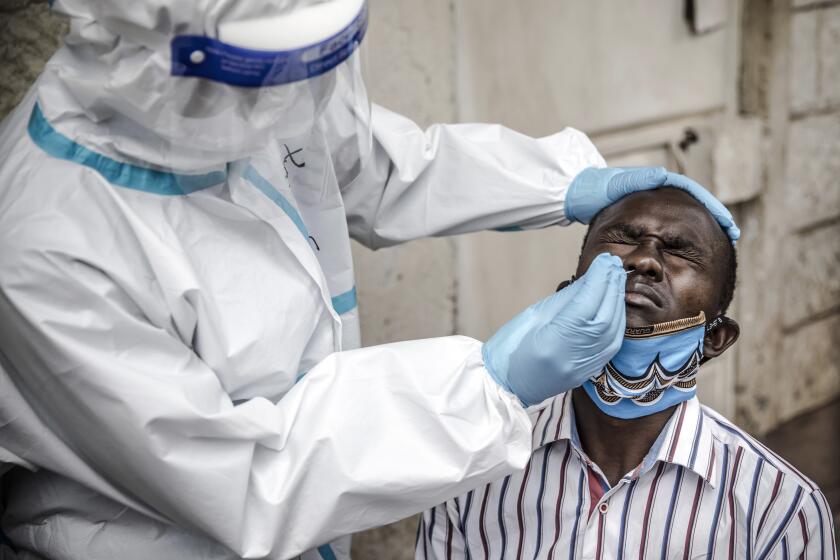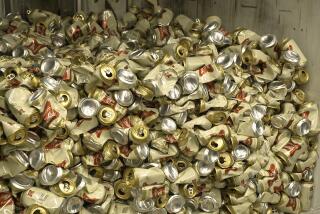Hold the Champagne: Pandemic, recession fears hammer traditional European products

- Share via
TOULOUSE, France — The pop of a Champagne cork: Around the world, but perhaps especially in France, few things better symbolize conviviality and celebration than the pouring out of fine bubbly and the clink of raised glasses. But the coronavirus crisis has changed all that.
With France in a near-total shutdown since March 17, large festive gatherings like weddings vanished overnight, restaurants and hotels were shuttered, export markets cratered, and one of the country’s most emblematic products suffered a sales collapse.
The pandemic has brought with it dire forecasts of Europe’s deepest recession of the postwar era. According to forecasts this month, the 27-nation European Union’s economy will shrink by 7.4% this year, the steepest fall in the bloc’s history.
Amid the wider economic peril, scores of prized regional European specialties — each of them redolent of local pride, cultural heritage and painstaking tradition — are taking a huge hit.
“Champagne is the drink of celebrations,” said Eric Marzec, an analyst for the market research firm IRI. “And the French are not in the mood to celebrate.”
In France, the list of world-renowned delicacies endangered by the outbreak includes foie gras — duck or goose liver — and Armagnac, the aromatic brandy produced in the country’s southwest.
In coronavirus-devastated Italy, the pandemic imperils iconic offerings like buffalo mozzarella. In Germany, Oktoberfest, the giant Bavarian beer bash, was canceled for the first time since World War II.
In a time of pandemic, bemoaning the fate of luxury goods like Champagne can seem jarring. But behind the high-end image of such products are not only many lives and livelihoods, but also a sense of national patrimony.
Champagne holds a particular place in the French imagination — and the annals of European Union bureaucracy. Under the bloc’s rules, sparkling wine isn’t Champagne unless it comes from the Champagne region of France. Across the continent, many other foods and beverages are similarly legally protected against imitators.
According to IRI, which tracks French shopping habits, direct consumer purchases of Champagne from stores have fallen up to 55% from the previous years. Some estimates place the overall decline in indirect sales, via hotels, restaurants and exports, at closer to 80%.
No one is sure how or when the industry might recover.
“In April, it was a disaster,” said Jean-Marie Barillère, co-president of the Comité Champagne, an industry group. “And I think it will be a disaster in May. And after that, it’s hard to know.”
Many countries saw the coronavirus as a ‘rich man’s disease’ imported by overseas travelers. It has since hit marginalized groups the hardest.
In Italy, sales of mozzarella di bufala, or creamy mozzarella made with buffalo milk, have fallen by as much as 40% as pizzerias, restaurants and hotels were forced to close nationwide on March 10, said Pier Maria Saccani, president of the Consortium for Mozzarella di Bufala Campana DOP.
“An immediate stop from one day to the next caused a lot of damage,” Saccani said, especially for a product such as mozzarella that has a short shelf life. “We’ve had to look for other distribution channels because when you have a product this fresh, you have to distribute it.”
The consortium represents about 90 mozzarella producers, most of them in the southern region of Campania near Naples, that meet the requirements for a European protected designation of origin. About 35% of the 50,000 tons of mozzarella they produce each year is exported to countries such as France, Germany and the U.S., meaning that grounded flights and uncertainty about truck transport — particularly at the beginning of the health crisis — contributed further to early losses.
The industry also involves about 350,000 buffalo raised across southern Italy that still need to be cared for.
“The animals produce milk every day — there’s no faucet,” Saccani said.
The buffalo, which have uniform dark brown coats and symmetrical light brown horns that grow back away from their faces, have been raised in and around Campania for the past 1,000 years.Monks in the countryside near Naples started using their milk to make cheese around the year 1200, according to the consortium.
As a result, mozzarella di bufala unites the territory and represents a sort of calling card for the region, with iconic images such as Mt. Vesuvius, mozzarella and Pompeii all connected in people’s minds, Saccani said.
The regional government has allocated about 19 million euros ($20.5 million) of financial aid for buffalo farmers, but the mozzarella producers themselves haven’t received any special government assistance. Normally the summertime is the busiest season of the year for mozzarella sales, as Italians and tourists alike flock to outdoor restaurants and pizzerias, but this year’s prospects remain uncertain.
“The situation is still evolving,” Saccani said. “We still need to see what consumers’ new habits will be and how that will impact our industry.”
In Champagne — the region, not the drink — the mood has been grim as producers try to navigate the uncertainty. Barillère said producers had taken advantage of some government financial support programs while also placing some employees on temporary unemployment.
But managing the vineyards requires vigilance. The weather this spring turned unseasonably warm, causing vines to grow quicker. So workers took to the fields sooner than usual to begin tending the vines and pruning while wearing masks and maintaining social-distancing rules.
Stocks of Champagne need regular attention, because it’s a product that is carefully built over several years. Bottles must be rotated as they ferment. Yeast and sugar must be added and then later filtered out.
Foreign tourists, who lug home edible and drinkable souvenirs, will likely be barred this summer, with the borders expected to remain closed, French President Emmanuel Macron has warned.
At Champagne Lanson, a house that traces its lineage to 1760, work had just been completed on a new reception area that would have opened this summer to welcome guests and host events.
Lanson also has the only vineyard in the Reims city limits, allowing visitors to see how the grapes are cultivated and then directly visit the production facilities. But it’s hard to know when the complex can welcome tourists, even domestic ones, because Reims lies in France’s “red zone” — meaning coronavirus infection rates there run high — requiring dates for reopening to be further delayed.
Thibault Marronnier, the North America manager for Lanson, says there has been a spirit of camaraderie as some employees who normally work in sales and marketing have agreed to work in the fields.
Across the Champagne region, the memory still lingers of World War I, when the fighting and trench warfare almost completely destroyed the vineyards. During World War II, the land was mostly spared, but Germans did their best to pilfer the best labels for consumption back home.
As they face the pandemic, which as of Monday had killed more than 284,000 people worldwide and infected more than 4.1 million, producers are trying to remain hopeful that the crisis may pass in time for a strong holiday season in November and December, when sales typically surge.
“These people have a very long-term perspective,” Marronnier said.
In the nearer future, there are worries about harvest season, which typically starts in August or September, depending on weather. Normally, about 50% of field workers come from Eastern Europe to pick the grapes. Champagne fields could instead find themselves competing with other French farmers for scarce labor.
And although unsold Champagne should still be in good condition to sell later, eventually production and storage facilities will run out of space as a new harvest comes in and production on future bottles begins.
Arnaud Molin, founder of e-commerce website Champmarket, said he’d seen increases in the number of people sending Champagne to friends as a present even if they couldn’t be together for a celebration.
And sales of half-bottles, typically bought by older consumers, have increased slightly. One of the classic problems with Champagne is it that doesn’t keep for long once opened, making it unappealing to open a bottle just for one glass.
Alexandra André, an independent public relations specialist, said she had a workaround for the Champagne storage dilemma: Drink it every day. While most of her friends on Zoom happy hours known as visio-apèro opt for beer or wine, André sticks with her favorite tipple.
But mainly, she’s looking forward to sharing a bottle with friends, as France begins a gradual reopening.
“Champagne is the drink we drink when we are feeling festive,” André said. “I’m sure that when confinement ends, people will be ready to toast.”
O’Brien and Brancolini, special correspondents, reported from Toulouse, France, and Milan, Italy, respectively. Times staff writer Laura King in Washington contributed to this report.
More to Read
Sign up for Essential California
The most important California stories and recommendations in your inbox every morning.
You may occasionally receive promotional content from the Los Angeles Times.











